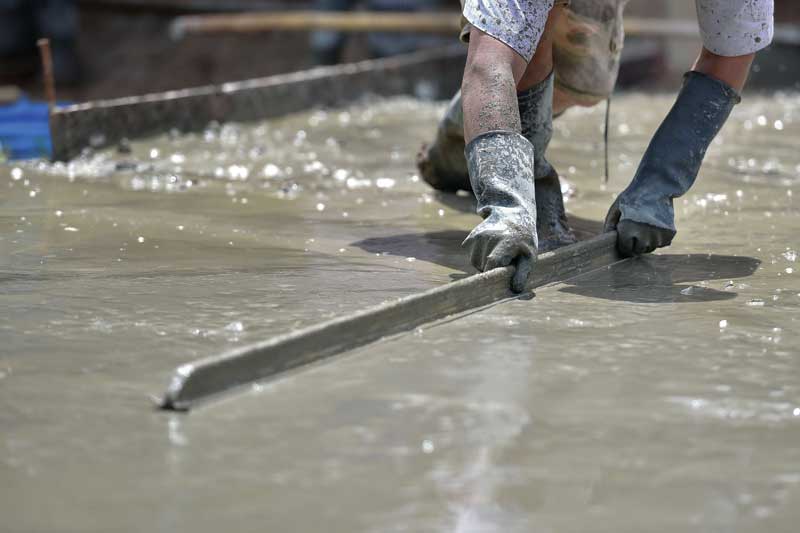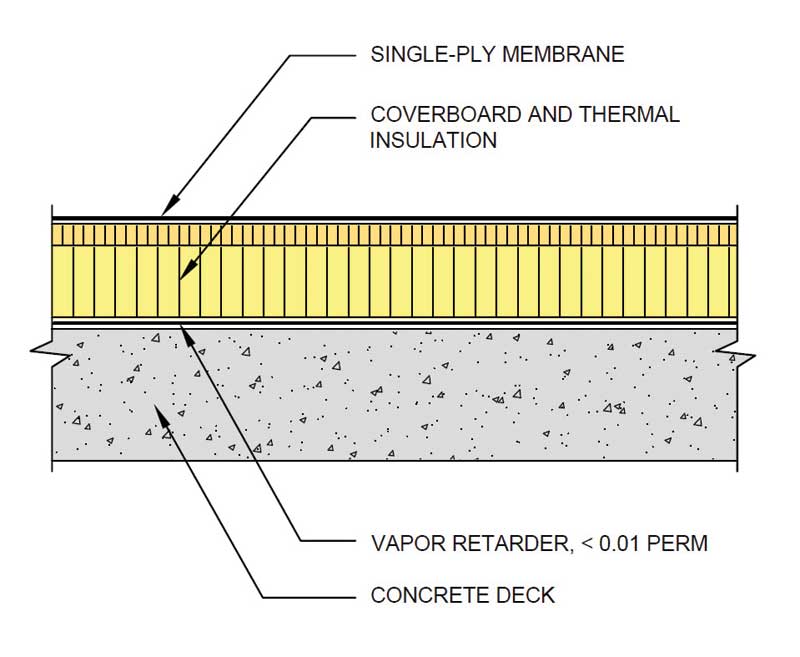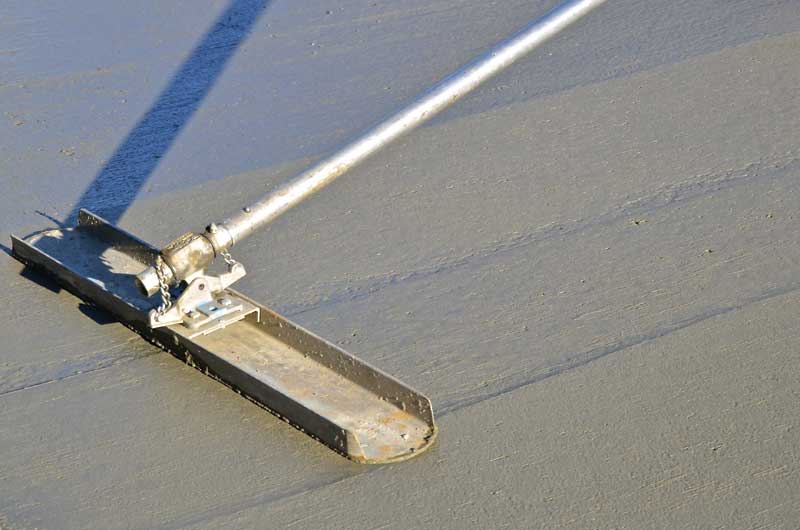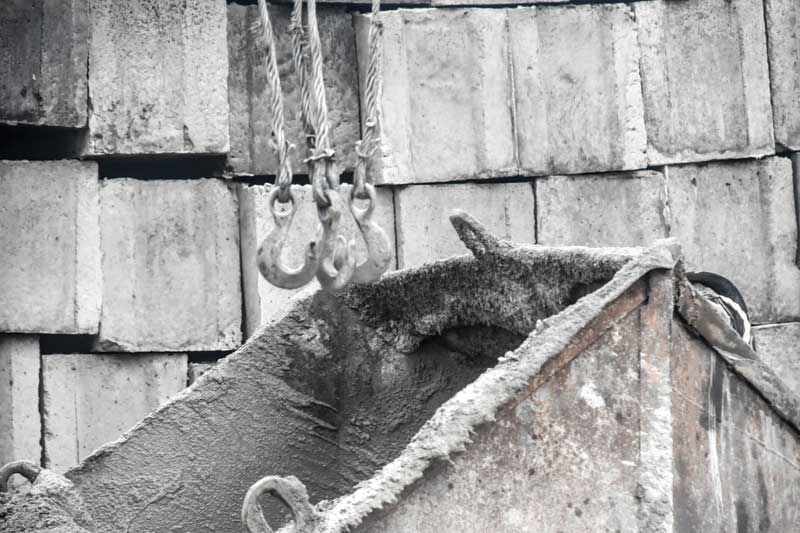Moisture in new concrete roof decks
by Katie Daniel | October 6, 2017 2:32 pm
 [1]
[1]by James R. Kirby, AIA
After steel and wood, concrete is one of the most common types of decks specified in the roofing industry. The material makes up 13 to 14 percent of the new and retrofit low-slope construction market, according to the National Roofing Contractors Association (NRCA) 2015−2016 Market Survey. However, challenges related to moisture still persist.
When a normal-weight structural concrete roof deck is poured (i.e. cast) in place, it contains a high level of water. However, when a lightweight structural concrete (LWSC) roof deck is poured in place, it uses significantly more water. The normal-weight concrete employs standard aggregates (i.e. hard rocks) with a low water absorption rate, and weighs approximately 2403 kg/m3 (150 lb/cf). LWSC employs shales and clays expanded with air to make them less dense, and weighs approximately 1922 kg/m3 (120 lb/cf). This means that LWSC absorbs significantly more water than normal-weight decks because of the different aggregates used. Just because LWSC is ‘lighter’ in terms of overall weight does not mean it absorbs less water.
Regardless of concrete type, additional water is often added to the mix to reduce viscosity and ensure concrete flows easily so there are no gaps or voids in the final product. Since concrete is made with aggregate that is often stored outdoors and uncovered, there can be water within the aggregate that goes into the concrete, again adding to the overall quantity of water in the mix. Traditional structural concrete aggregates normally have low water content, while LWSC aggregate is intentionally loaded with water because of the voids. This is necessary so the water needed for hydration is not pulled into the voids in the LWSC aggregate.
Beyond the lower weight, LWSC’s advantages include less cracking and shrinking. The material may also have a better fire rating per unit of thickness depending on the classifications being used. The reduced density relative to normal-weight concrete also means the material’s transportation and handling costs are lowered, therefore reducing overall energy consumption. Use of LWSC can also help a project garner points under the Leadership in Energy and Environmental Design (LEED) green building rating program. Consequently, use of LWSC has increased over the past decade.
 [2]
[2]Image courtesy MRCA
Typically the roofing industry has required a 28-day curing period prior to testing the deck for ‘dryness’ and suitability for roofing. This suggested length of time comes not from NRCA, but was garnered from the concrete industry’s recommendation for the appropriate amount of time for concrete to cure and develop adequate compressive strength. However, the 28-day time frame is not related to the amount of water in the concrete—only to the cure time. The roofing industry now understands concrete continues to cure and releases excess moisture (i.e. dries out) for a significant time. It is important to note LWSC’s higher moisture content relative to normal-weight concrete means a much longer drying time is needed.
When a concrete deck is poured, some of the mix water is used up in chemical hydrations as the concrete cures, and some evaporates. Nevertheless, the rate of evaporation is slow, so large quantities of water remain stored within the structure of the concrete for extended periods. Moisture retention is exacerbated by construction methods when concrete is installed over nonremovable metal forms (or other impermeable substrates). While moisture generally does not damage the concrete itself, it typically migrates into the roofing system where it is absorbed by materials that are more sensitive.
The problem
In recent years, the roofing industry has become increasingly aware of the problems caused by moisture in concrete decks that can migrate into the roofing system. Originally thought to only be a problem with LWSC, recent research raises concerns with moisture migration from normal concrete decks as well. Shorter construction schedules and moisture-sensitive roof system components can aggravate the problem.
Additionally, rewetting of exposed concrete decks adds additional moisture, raising the relative humidity (RH) of the concrete. As rewetting is a function of precipitation and drying rates of specific geographic locations, the project location matters. There is less rewetting and more drying in hot, arid areas like the Southwest; there is more rewetting and less drying in mild climates that experience even moderate amounts of precipitation. This latent moisture in concrete (from the mix water and rewetting) is of significant concern. While the sustainability movement is advancing the use of LWSC, the roofing industry is dealing with some of the material’s unintended consequences.
Historically, most roof systems were adhered to concrete decks using hot asphalt applied in a continuous fashion, creating a monolithic membrane system. This inherently resulted in a vapor retarder between the concrete and the roof system, preventing moisture migration from the concrete into the roof system.
 [3]
[3]Photos © Crystal Graphics. Photos courtesy GAF
Today’s roof systems often do not use a vapor retarder at the roof deck. Designs employ newer methods to attach to concrete decks, including ribbon-patterned foam and asphalt adhesives. Loose-laid stone ballast may also be used above the roof membrane to secure it to the deck.
According to Portland Cement Association (PCA) Engineering Bulletin (EB) 119, Concrete Floors and Moisture, normal-weight structural concrete will dry down to a 75 percent RH in approximately three months. However, LWSC takes nearly six months to dry to that level. (This information is based on a 200-mm [8-in.] thick concrete slab that has not been rewetted, with drying potential on the top and bottom.) If downward drying is not possible, clearly the time to dry to 75 percent RH will be extended.
A 1997 study by the Swedish Council of Research showed it can take up to six months (180 days) to reach an 85 percent RH when the water-to-cement (w/c) ratio is high (e.g. 0.7). Even with a low w/c ratio (e.g. 0.4), it takes almost two months (50 days) to reach an 85 percent RH. Suffice it to say, concrete takes a long time to dry.
While the primary function of a roofing system is to prevent water from passing into the building below, water or vapor collecting within the roofing system can also be detrimental, both to the roofing system’s immediate performance and its long-term durability. Aside from leakage to the interior, moisture in roofing systems can have numerous negative consequences, including reduced thermal resistance of insulation and loss of strength of the insulation, coverboard, adhesive, or fasteners. If moisture affects the attachment of the roofing system, significant property loss can occur. These effects could leave the roofing system vulnerable to:
- uplift damage from wind;
- crushing from foot traffic or hail;
- deterioration of the structural deck;
- dimensional changes in the substrate (which can, in turn, damage the roof membrane);
- blistering or weakening of the roof membrane itself; and
- mold growth.
Testing for dryness
The top surface of a concrete deck may be adequately dry to install a roofing system. However, the amount of moisture contained in the lower two-thirds to three-quarters of the concrete deck can be driven upward into the roof system over time. There is a significant difference between surface-dry concrete that provides the ability to adhere a roof system and an appropriately dry concrete deck that will not affect the performance of a roof system over an extended period.
Numerous methods have been traditionally used in the roofing industry to determine if a concrete deck is appropriate for installation. One method is to assume after 28 days the deck is adequately dry. This is certainly not appropriate.
Another approach is to mop or pour hot bitumen on a concrete deck and check for bubbling or sizzling (e.g. small bubbles closely spaced) that indicate moisture is boiling out of the deck. However, this method is not reliable, as it only determines whether the very top surface is wet or dry.
ASTM D4263, Standard Test Method for Indicating Moisture in Concrete by the Plastic Sheet Method, calls for a plastic sheet or piece of glass to be placed over the deck and sealed to determine if condensation develops, therefore indicating moisture is present in the concrete. This method is also unreliable because environmental conditions (e.g. temperature, humidity, and solar gain) must be the same on the top and bottom of the concrete deck, which is difficult to achieve.
A potential—but yet to be qualified—method comes from the flooring industry. ASTM F2170, Standard Test Method for Determining Relative Humidity in Concrete Floor Slabs Using In-situ Probes, involves inserting a probe into a drilled hole, which is then sealed and left in place for three days to measure temperature and RH. This test method is currently unacceptable for concrete roof decks because there is no current index/measure for an appropriate relative humidity at different depths within a concrete deck. For normal- and lightweight structural concrete, NRCA suggests a maximum 75 percent RH, and understands a lower level of humidity may be required when organic-based materials are employed in the roof assembly.
Other test methods using electrical resistance and impedance are not common in North America. More importantly, they do not determine the amount of moisture in a concrete deck except at very shallow depths—the results are not a reliable measure for installation of roof systems.
| FURTHER INFORMATION |
For additional data and context, this author recommends the following sources:
|
 [4]
[4]Recommendations
Several technical advisories have been issued to raise awareness about the potential for roof failures over structural concrete roof decks. NRCA’s August 2013 Industry Issue Update (“Moisture in Lightweight Structural Concrete Roof Decks”) recommends avoiding use of lightweight structural concrete in new construction. The Asphalt Roofing Manufacturers Association (ARMA) has issued a technical bulletin about performance concerns, “ARMA Lightweight Structural Concrete Roof Decks Statement.” In July 2013, the Single-ply Roofing Industry (SPRI), Polyisocyanurate Insulation Manufacturers Association (PIMA), and RCI International issued a joint Technical Bulletin—“Moisture Concerns in Roofing Systems Applied Over Lightweight Structural Concrete Roof Decks”—regarding moisture concerns with concrete roof decks.
Although allowing concrete to thoroughly dry is the most appropriate option, this can be reasonably impractical. More realistic ideas that can be implemented are explored in the paragraphs that follow this section.
Vapor retarders on the top surface of the concrete deck
In its May 2017 Technology & Research Update, the Midwest Roofing Contractors Association (MRCA) advises a vapor retarder of less than 0.01 perm is necessary over new concrete roof decks. From a practical standpoint, a vapor retarder of less than 0.01 perm is effectively a vapor barrier—almost no moisture passes through to the roof system above.
There are three classes of vapor retarders/barriers—Class I, II, and III—with each having varying permeability ratings. A Class I vapor retarder has a perm rating of 0.01 to 0.1; a Class II vapor retarder has a perm rating of 0.1 to 1.0; and a Class III vapor retarder has a perm rating of 1 to 10. MRCA is advising to use a better-than-Class 1 vapor retarder over new concrete roof decks because of its ability to prevent moisture from entering the roof system.
This demands a word of caution, however: designers must consider the potential issues with installing a roofing system with a ‘double vapor barrier’—one at the roof deck and then the roof membrane itself—as it theoretically does not allow escape of moisture that is trapped in it or gets into the system. A potential solution is to use one-way vents in the roof membrane to allow moisture to escape, but not enter.
Venting bases
Use of a venting base sheet in conjunction with vents and venting edge details (at edges and parapets and penetrations) helps provide a pathway to allow the moisture in a wet concrete deck to escape slowly over time. This follows methods employed when lightweight insulating concrete is installed.
| JUMP |
| JUMP is an online crowdsourcing hub with 1400 registered users, and is a portal to collaboration in the buildings technology space. It invites industry partners to share their technical challenges with community members who are invited to submit their solutions, with the best potentially qualifying for cash awards and in-kind technical support to bring their ideas from drawing board to production line.Oakridge National Laboratory (ORNL) partnered with various manufacturers, including this author’s employer, to reach out to the technical community through the JUMP program to develop new materials and installation methods that can be employed with a concrete deck to significantly reduce the likelihood of moisture-related problems. The difficulties to consider include vapor drive, cost/ease of installation, attachment methods for the roof system, and how to assess success.Submissions were due in late August. At the time of writing this article, a number of submissions have been received, and its sponsors are hopeful a novel idea will be brought forward and make its way to the commercial market. More information can be found at www.jump.ideascale.com[5]. |
Other possibilities
The concrete industry uses admixtures for myriad reasons. Some purport one benefit is to reduce the amount of water vapor from concrete decks. Laboratory tests and field experience suggest they have little effect. Therefore, use of concrete admixtures does not appear to be a panacea for the effects of latent moisture in concrete roof decks.
There is discussion the color of the roof surface has some effect on the issue of wet concrete. A black/low-reflectance/high-solar-gain membrane, because its temperature is warmer than a white/highly reflective roof, will drive moisture out of a roof system. However, the color of the roof surface has not been definitively deemed as a problem or a solution. What is known is a compressed construction schedule that pushes roof installation shortly after the installation of a concrete deck does not allow for adequate drying time.
Last year, NRCA, Chicago Roofing Contractors Association, Canadian Roofing Contractors Association, and a pair of roofing manufacturers began sponsoring research that includes outdoor exposure, indoor/lab exposure, lab-based hydrothermal measurements, instrumentation, and modeling (using WUFI software). The research seeks to analyze normal-weight versus LWSC with respect to:
- the surface finish;
- rewetting;
- drying capacity (one-way and two-way drying);
- moisture over time; and
- time for instruments to measure moisture levels.
The work is ongoing, and it will continue into 2018 with the validation of the computer modeling.
Conclusion
It is incumbent on specifiers and designers of roof systems that will be installed over new concrete decks to understand the issues with normal- and lightweight structural concrete. General contractors should recognize compressing construction schedules exacerbates these issues because of inadequate drying time, and it may be appropriate for these contractors to use protective tarps or tents to prevent rewetting of concrete decks.
| ‘WET’ CONCRETE ROOF DECKS TRIGGER A SHARP RISE IN LITIGATION |
| Roofing contractors have been installing new roofs over new concrete roof decks for decades. However, litigation initiated by property owners over roof system failures caused by concrete deck-sourced moisture can no longer be ignored.
By 2011, several research papers had been introduced at the International Roofing Symposium concerning roofing over new concrete decks. “Currently, we have a pile of legal cases in our files. Even one that was initiated in 2012 and is now going to trial in 2017,” says Matt Dupuis, PhD, PE, principal of Middleton, Wisconsin-based Structural Research Inc. (SRI). “These cases are leaving all the parties involved in the construction process ‘on the hook’ from a legal perspective.” His father Rene Dupuis, PhD, PE, helped found SRI in 1978. Since that time, the company has been a highly active research firm in the commercial roofing industry. At this writing, the company is attempting to quantify through current research factors contributing to concrete roof deck failures in new construction applications. The decision to use a concrete roof deck begins with the structural engineer or architect, who makes a conscious choice based on his or her priorities. These can run the gamut from pursuing points under the Leadership in Energy and Environmental Design (LEED) program to construction in seismic zones. In the latter case, use of a lightweight concrete deck will give the designer benefits by being able to build higher while limiting seismic sway. “It’s important specifiers understand the difference between lightweight concrete decks curing and lightweight concrete decks drying,” emphasizes Dupuis. “These are two completely different events.” Specifically, curing relates to a chemical process wherein the concrete goes from a liquid to a solid state and gains strength. This chemical process proceeds at a well-documented rate. The drying of concrete is less understood by those working with the building envelope. “The tests we have in our inventory are only testing for the presence of moisture at the surface of the concrete,” says Dupuis. “Typically, we are talking well less than [25 mm] 1 in. deep. This doesn’t help much when we roof over a deck and leave it for years. It takes time, but the moisture will move up through the concrete and make its presence known within the roof system.” Until the roofing industry can determine a safe drying time for concrete decks, Dupuis recommends using a “heavy” vapor retarder with a perm rating of 0.01. Specifiers can also opt for doubling-up popular peel-and-stick membranes for a similar perm rating. “Roof system manufacturers are responding and coming out with solutions in terms of systems and product recommendations—you just need to ask for them,” he says. “Putting a few dimes in per square foot for a vapor retarder is worth avoiding a potentially catastrophic roof failure and thousands or millions of dollars in legal fees.” |
James R. Kirby, AIA, is GAF’s building and roofing science architect for the East Coast. He has a master’s degree in architectural structures, is a licensed architect, and has nearly 25 years of experience in the roofing industry. Kirby’s work has ranged from forensic investigation to technical writing, speaking, and education. He is a member of the American Institute of Architects (AIA), ASTM International, International Code Council (ICC), Midwest Roofing Contractors Association (MRCA), National Roofing Contractors Association (NRCA), RCI International, and the U.S. Green Building Council (USGBC). Kirby can be reached at jkirby@gaf.com[6].
- [Image]: https://www.constructionspecifier.com/wp-content/uploads/2017/10/bigstock-156046811.jpg
- [Image]: https://www.constructionspecifier.com/wp-content/uploads/2017/10/Figure-1.jpg
- [Image]: https://www.constructionspecifier.com/wp-content/uploads/2017/10/Photo-1.jpg
- [Image]: https://www.constructionspecifier.com/wp-content/uploads/2017/10/Photo-2.jpg
- www.jump.ideascale.com: http://www.jump.ideascale.com
- jkirby@gaf.com: mailto:jkirby@gaf.com
Source URL: https://www.constructionspecifier.com/moisture-new-concrete-roof-decks/